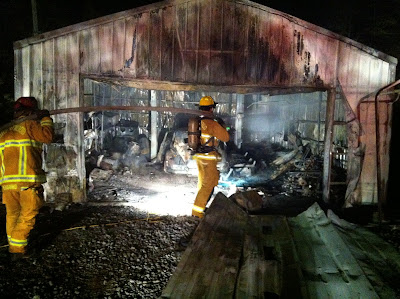If you’ve ever driven past a fire
station in the morning and seen or heard the firefighters’ saws running, you
may be wondering what they are up to. Firefighters carry a variety of tools,
including several types of saws. Brentwood fire engines are equipped with
traditional chainsaws like you may have in your own garage. These are used for
when storms blow trees or tree limbs down and block roadways. If there is no
one available from public works to clear the roadway (for example on a holiday
or in the middle of the night) the firefighters will be sent out to remove the
hazard.
However, there are two other saws
carried on the engines that are not like anything you’ll find at a home
improvement store.
The Cutter’s Edge, shown here in
the foreground, and the K12 Rotary Saw, in the back, are stored in compartments
on the fire truck where they are easily accessible and ready to go at a
moment’s notice. What you see some mornings are the firefighters doing their
bi-weekly check of the saws.
Firefighters will clean and inspect the saws. They want to ensure that they are fueled up and properly lubricated. The chain or blades are inspected and tightened if needed. Once the firefighter is certain the saw is safe and ready to go, he will take it outside and start it.
Once the saw is running, it is
allowed to idle for a short time to warm up. During this time the firefighter
is listening to make sure it is running smoothly and that there are no hiccups.
After allowing the saw to warm up, the firefighter will give it a few revs. Once the firefighter is sure the saw will perform when needed, he or she will set it back down and allow it to idle again for a short time. During weekly testing, the saws are allowed to warm up and cool down to help ensure longer life. However, during an emergency these tools don’t get such gentle treatment. They may be called upon to go from sitting in the compartment to running full throttle for an extended period of time with little or no warm up period. This is why it is so vital for a firefighter to closely inspect each saw twice a week.
If you’ve ever seen a firefighter
on the roof of a burning house cutting a hole, chances are they were using the
Cutter’s Edge. While it may look like a simple chainsaw, the Cutter’s Edge has
a specially designed chain that allows it to quickly and efficiently cut
through layers of shingles, tar paper, roofing nails, plywood decking and
anything else that gets in its way. This saw is also equipped with a brake,
which prevents the chain from moving. That way when one firefighter has to pass
a running saw to another the chance for injury is reduced.
While the Cutter’s Edge is the
tool of choice for ventilating a structure when cutting a hole in the roof,
caution must be exercised when cutting a roof not to go so deep as to cut
through the supports of the roof. The goal here is to make an opening for the
smoke to escape without weakening the roof to the point of collapse.
Once the cut has been made, hand
tools are used to push the pieces of the roof out of the way and puncture the
drywall below. This gives the smoke, heat and toxic gasses a way to escape the
structure.
The K12 Rotary Saw is a powerful
variant of a construction tool. These saws have interchangeable blades that
allow them to be used on an assortment of materials so that Firefighters can
choose the best blade for the task at hand. Metal cutting blades allow
firefighters to remove burglar bars, steel security doors and garage doors or
even access the engine compartment of a damaged vehicle. Masonry blades make
short work of cinder blocks and can even cut concrete and brick. Firefighters
can also outfit the K12 with a wood cutting blade for times when the Cutter’s
Edge may not be the most efficient choice.
The days of using axes and other
hand tools as the sole means of accomplishing a task are long gone. These saws are
one more useful tool that Brentwood firefighters can use to accomplish their
mission.































